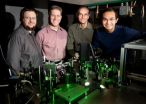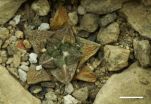(Press-News.org) CAMBRIDGE, Mass. -- In a new study to be published in the Nov. 25 issue of Nature, MIT cancer biologists show that restoring the protein p53's function in mice with lung cancer has no effect early in tumor development, but restoring the function later on could prevent more advanced tumors from spreading throughout the body.
Cancer researchers have known since the 1980s that p53 plays a critical role in protecting cells from becoming cancerous. P53 is defective in about half of all human cancers; when it functions correctly, it appears to suppress tumor formation by preventing cells with cancer-promoting mutations from reproducing. Knowing p53's critical role in controlling cancer, researchers have been trying to develop drugs that restore the protein's function, in hopes of reestablishing the ability to suppress tumor growth. One such drug is now in clinical trials.
The findings of this new study suggest that drugs that restore p53 function could help prevent aggressive lung cancers from metastasizing, though they might spare benign tumor cells that could later turn aggressive. "Even if you clear the malignant cells, you're still left with benign cells harboring the p53 mutation," says David Feldser, lead author of the paper and a postdoctoral fellow at the David H. Koch Institute for Integrative Cancer Research at MIT.
However, such drugs are still worth pursuing because they could prolong the life of the patient, says Feldser, who works in the lab of Koch Institute Director Tyler Jacks, senior author of the paper. The research was funded by the Howard Hughes Medical Institute.
P53 is known to control the cell cycle, which regulates cell division. In particular, the protein stops a cell from dividing when its DNA is damaged. P53 then activates DNA repair systems, and if the damage proves irreparable, it instructs the cell to commit suicide.
Without p53, cells can continue dividing even after acquiring hazardous mutations. Eventually, after a cell accumulates enough mutations, it becomes cancerous. Cancer biologists believe that sustained inactivation of p53 and other tumor suppressors is necessary for cancers to become advanced.
In the new Nature study, the MIT researchers studied mice that are genetically engineered to develop lung tumors shortly after birth. Those mice also have an inactive form of the p53 gene, but the gene includes a genetic "switch" that allows the researchers to turn it back on after tumors develop.
At first, the researchers turned on p53 in mice that were four weeks old and had developed tumors known as adenomas, which are benign. To their surprise, restoring p53 had no effect on the tumors.
Next they turned on p53 in another group of tumor-prone mice, but they waited until the mice were 10 weeks old. At this point, their tumors had progressed to adenocarcinomas, a malignant type of cancer. In these mice, turning on p53 cleared the malignant cells, but left behind cells that had not become malignant.
This suggests that the p53 signaling pathway is recruited only when there is a lot of activity from other cancer genes. In benign tumors, there is not enough activity to engage the p53 system, so restoring it has no effect on those tumors. In the malignant tumor cells, reactivated p53 eliminates cells with too much activity in a signaling pathway involving mitogen-activated protein kinase (MAPK), which is often overactive in cancer cells, leading to uncontrolled growth.
The MIT researchers are now looking for drugs that reactivate mutant forms of p53, and also plan to study whether tumors that have metastasized would be vulnerable to p53 restoration.
###
Source: "Stage-specific sensitivity to p53 restoration during lung cancer progression," by David M. Feldser, Kamena K. Kostova, Monte M. Winslow, Sarah E. Taylor, Chris Cashman, Charles A. Whittaker, Francisco J. Sanchez-Rivera, Rebecca Resnick, Roderick Bronson, Michael T. Hemann, and Tyler Jacks. Nature, 25 November 2010.
Funding: The Howard Hughes Medical Institute
END
CHAMPAIGN, Ill. – The long, anxious wait for biopsy results could soon be over, thanks to a tissue-imaging technique developed at the University of Illinois.
The research team demonstrated the novel microscopy technique, called nonlinear interferometric vibrational imaging (NIVI), on rat breast-cancer cells and tissues. It produced easy-to-read, color-coded images of tissue, outlining clear tumor boundaries, with more than 99 percent confidence – in less than five minutes.
Led by professor and physician Stephen A. Boppart, who holds appointments in electrical and computer ...
MEDFORD/SOMERVILLE, Mass. -- Some of the universe's most massive galaxies may have formed billions of years earlier than current scientific models predict, according to surprising new research led by Tufts University. The findings appear in the Astrophysical Journal published online Nov. 24 in advance of print publication on Dec. 10, 2010.
"We have found a relatively large number of very massive, highly luminous galaxies that existed almost 12 billion years ago when the universe was still very young, about 1.5 billion years old. These results appear to disagree with ...
Children living in disadvantaged neighbourhoods are more likely to succeed if they participate in a community-based prevention program, according to findings released recently from a multi-year research study based at Queen's University.
Children participating in the Better Beginnings, Better Futures (BBBF) project showed improved social and academic functioning. The project also impacted positively on families and on neighbourhoods.
"The results from our study indicate that the project has been a success," says Queen's psychology professor emeritus Ray Peters, the ...
Electrical engineers generated short, powerful light pulses on a chip – an important step toward the optical interconnects that will likely replace the copper wires that carry information between chips within today's computers. University of California, San Diego electrical engineers recently developed the first ultra compact, low power pulse compressor on a silicon chip to be described in the scientific literature. Details appeared online in the journal Nature Communications on November 16.
This miniaturized short pulse generator eliminates a roadblock on the way to ...
A new chemical analysis technique developed by a research group at the National Institute of Standards and Technology (NIST) uses the shifting ultrasonic pitch of a small quartz crystal to test the purity of only a few micrograms of material. Since it works with samples close to a thousand times smaller than comparable commercial instruments, the new technique should be an important addition to the growing arsenal of measurement tools for nanotechnology, according to the NIST team.
As the objects of scientific research have gotten smaller and smaller—as in nanotechnology ...
Suspicious packages and powders have triggered more than 30,000 responses by U.S. law enforcement agencies across the country since 2001. These events are expensive, time-consuming and potentially dangerous. To help first responders at all levels of government deal safely and more effectively with suspected biothreat agents, the National Institute of Standards and Technology (NIST) and a broad team of federal, state and local agencies and other organizations worked together to update an existing standard for sample collection and develop overall guidance for when to collect ...
As the cholera epidemic in Haiti continues to rage, public health workers are focusing their efforts on treating the tens of thousands who have already been hospitalized with cholera-like symptoms and providing clean water and adequate sanitation to control the disease's spread.
Could the United States be doing more to help the situation? In an editorial published in the November 24, 2010, issue of the New England Journal of Medicine, vaccine and infectious disease specialists Matthew Waldor of the Howard Hughes Medical Institute, Peter Hotez of George Washington University ...
In the scorching summer heat of the Chihuahuan Desert in southwest Texas, air temperatures can hover around 97°F (36°C) while at the surface of the soil temperatures can exceed 158°F (70°C). Encountering these extreme temperatures, plants must utilize creative methods to not only survive but thrive under these difficult and potentially lethal conditions.
This new work by Dr. Gretchen North and colleagues, published in the December issue of American Journal of Botany (http://www.amjbot.org/cgi/reprint/ajb.1000286v1), sheds light on how one desert resident, the cactus ...
Scientists have discovered an amazingly simple way that cells stabilize their machinery for forcing apart chromosomes. Their findings are reported Nov. 25 in Nature.
When a cell gets ready to split into new cells, this stable set-up permits its genetic material to be separated and distributed accurately. Otherwise, problem cells – like cancer cells— arise.
The human body contains more than a trillion cells, and every single cell needs to have the exact same set of chromosomes. Mistakes in moving chromosomes during cell division can lead to babies being born with ...
Merrill Corporation (www.merrillcorp.com), a leading global provider of technology-enabled services, today announced its Lextranet Certification Program for contract attorney reviewers. Lextranet is a single, secure and scalable online review and hosting platform that provides on-demand access for easy review of small or large document collections. The program will enhance Merrill's integrated hosting and review offering by ensuring that reviewers have the knowledge and skills necessary to maximize the features built into Lextranet.
"As a result of the training, document ...




